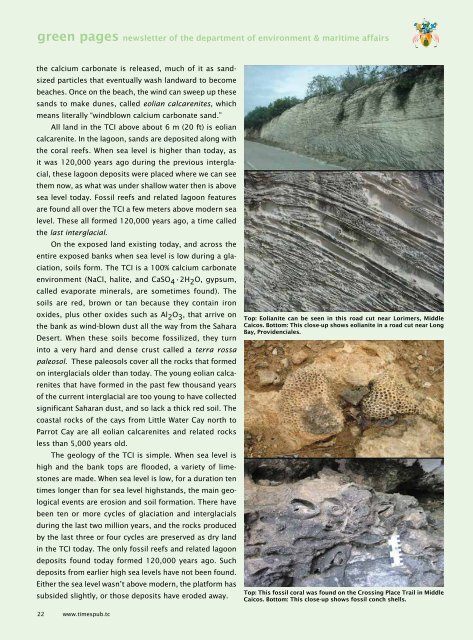Times of the Islands Summer 2016
Presents the "soul of the Turks & Caicos Islands" with in-depth features about local people, culture, history, environment, businesses, resorts, restaurants and activities.
Presents the "soul of the Turks & Caicos Islands" with in-depth features about local people, culture, history, environment, businesses, resorts, restaurants and activities.
You also want an ePaper? Increase the reach of your titles
YUMPU automatically turns print PDFs into web optimized ePapers that Google loves.
green pages newsletter <strong>of</strong> <strong>the</strong> department <strong>of</strong> environment & maritime affairs<br />
<strong>the</strong> calcium carbonate is released, much <strong>of</strong> it as sandsized<br />
particles that eventually wash landward to become<br />
beaches. Once on <strong>the</strong> beach, <strong>the</strong> wind can sweep up <strong>the</strong>se<br />
sands to make dunes, called eolian calcarenites, which<br />
means literally “windblown calcium carbonate sand.”<br />
All land in <strong>the</strong> TCI above about 6 m (20 ft) is eolian<br />
calcarenite. In <strong>the</strong> lagoon, sands are deposited along with<br />
<strong>the</strong> coral reefs. When sea level is higher than today, as<br />
it was 120,000 years ago during <strong>the</strong> previous interglacial,<br />
<strong>the</strong>se lagoon deposits were placed where we can see<br />
<strong>the</strong>m now, as what was under shallow water <strong>the</strong>n is above<br />
sea level today. Fossil reefs and related lagoon features<br />
are found all over <strong>the</strong> TCI a few meters above modern sea<br />
level. These all formed 120,000 years ago, a time called<br />
<strong>the</strong> last interglacial.<br />
On <strong>the</strong> exposed land existing today, and across <strong>the</strong><br />
entire exposed banks when sea level is low during a glaciation,<br />
soils form. The TCI is a 100% calcium carbonate<br />
environment (NaCl, halite, and CaSO 4 •2H 2 O, gypsum,<br />
called evaporate minerals, are sometimes found). The<br />
soils are red, brown or tan because <strong>the</strong>y contain iron<br />
oxides, plus o<strong>the</strong>r oxides such as Al 2 O 3 , that arrive on<br />
<strong>the</strong> bank as wind-blown dust all <strong>the</strong> way from <strong>the</strong> Sahara<br />
Desert. When <strong>the</strong>se soils become fossilized, <strong>the</strong>y turn<br />
into a very hard and dense crust called a terra rossa<br />
paleosol. These paleosols cover all <strong>the</strong> rocks that formed<br />
on interglacials older than today. The young eolian calcarenites<br />
that have formed in <strong>the</strong> past few thousand years<br />
<strong>of</strong> <strong>the</strong> current interglacial are too young to have collected<br />
significant Saharan dust, and so lack a thick red soil. The<br />
coastal rocks <strong>of</strong> <strong>the</strong> cays from Little Water Cay north to<br />
Parrot Cay are all eolian calcarenites and related rocks<br />
less than 5,000 years old.<br />
The geology <strong>of</strong> <strong>the</strong> TCI is simple. When sea level is<br />
high and <strong>the</strong> bank tops are flooded, a variety <strong>of</strong> limestones<br />
are made. When sea level is low, for a duration ten<br />
times longer than for sea level highstands, <strong>the</strong> main geological<br />
events are erosion and soil formation. There have<br />
been ten or more cycles <strong>of</strong> glaciation and interglacials<br />
during <strong>the</strong> last two million years, and <strong>the</strong> rocks produced<br />
by <strong>the</strong> last three or four cycles are preserved as dry land<br />
in <strong>the</strong> TCI today. The only fossil reefs and related lagoon<br />
deposits found today formed 120,000 years ago. Such<br />
deposits from earlier high sea levels have not been found.<br />
Ei<strong>the</strong>r <strong>the</strong> sea level wasn’t above modern, <strong>the</strong> platform has<br />
subsided slightly, or those deposits have eroded away.<br />
Top: Eolianite can be seen in this road cut near Lorimers, Middle<br />
Caicos. Bottom: This close-up shows eolianite in a road cut near Long<br />
Bay, Providenciales.<br />
Top: This fossil coral was found on <strong>the</strong> Crossing Place Trail in Middle<br />
Caicos. Bottom: This close-up shows fossil conch shells.<br />
22 www.timespub.tc

















